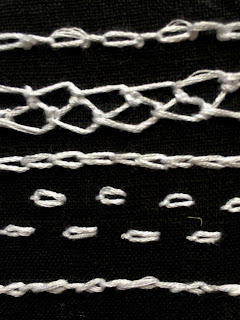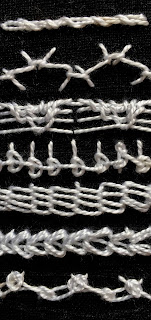It was a matter of identifying a simple shape consistent through out the rubbing and choosing a stitch
to represent it. This was intriguing as the rubbings reveal very different markings. I also did some rubbings on fabric and then stitch into those which was very effective.
10.1 Stitched translation of rubbing of tissue paper relief representing Teasels
The rubbing of the teasels bore some resemblance to the paper relief
showing longitudinal marks diagonally and vertically across the
sample.
For this I used Chain Stitch in its many variations including
detached chain, elongated detached chain some with long or short
tails, and a twisted chain to couch the stems.
It is worked over a rubbing on chiffon over linen. I’m really
pleased with this and the rubbing adds a beautiful ethereal feel.
Threads used are rayon ribbon, fine crochet cotton and cotton perle.
There is a fabric rubbing in the surround [top right] on polycotton.
You may have noticed that I've placed the chiffon on the linen the wrong way round so the teasels are placed opposite ways to the rubbing but I didn't have the heart to undo it!
10.2 Stitched translation of rubbings scrunched tissue and chocolate box paper relief representing Ivy, stick & undergrowth
A stitched sample
worked in Double Knot or Palestrina Stitch on linen.
This was inspired by
the knotted appearance of the rubbing [top left]. I was fascinated by
how different in appearance this was from the paper relief and loved
the feeling of rhythm and movement it brought to the work.
The threads used
were silk yarn, Gutterman polyester machine thread, rayon ribbon,
linen thread, cotton perle and a wool yarn.
I have included some
rubbings on fabric as the surround which are : centre right –
Markel stick on linen; bottom right Markel stick on polycotton and
centre Markel stick on chiffon over linen.
10.3 Stitched translation of rubbings of scrunched and folded tracing and grease proof paper relief representing an Ivy Clad
Ditch
Again the rubbings gave a different impression to the paper relief
and suggestive of arrows shooting off in every direction hence my
choice of Arrow Stitch worked in various sizes and directions in
strips of Chinese silk plus single and double thickness linen thread.
There is a rubbing on polycotton fabric on the centre right.
I certainly had to look harder at the rubbing as I stitched on the
bare fabric.
10.4 Stitched translation of rubbings of strips of gathered copy paper relief to represent Cow
Parsley
I was delighted with this rubbing. I adore cow parsley and the sight
of it immediately transports me home to the Somerset Levels!
Fly Stitch instantly revealed itself to me and I decided to use it as
I had in my informal sample [chapter 9] in a clockwise fashion to
form circles, other stitches are worked around the edges according to
the rubbing.
I’ve used linen threads of different thicknesses
I worked on the polycotton rubbing to demonstrate the effect as I’d
already used the chiffon in sample 10.1 although I think the rubbing
on chiffon on the left surround is really beautiful, I’d use this
instead in the future as I think it captures the fairyland feel that
cow parsley can give.
I'm really proud of the work in the last 3 chapters and I'm looking forward to the next and the challenges it brings as I work towards the final piece.

































